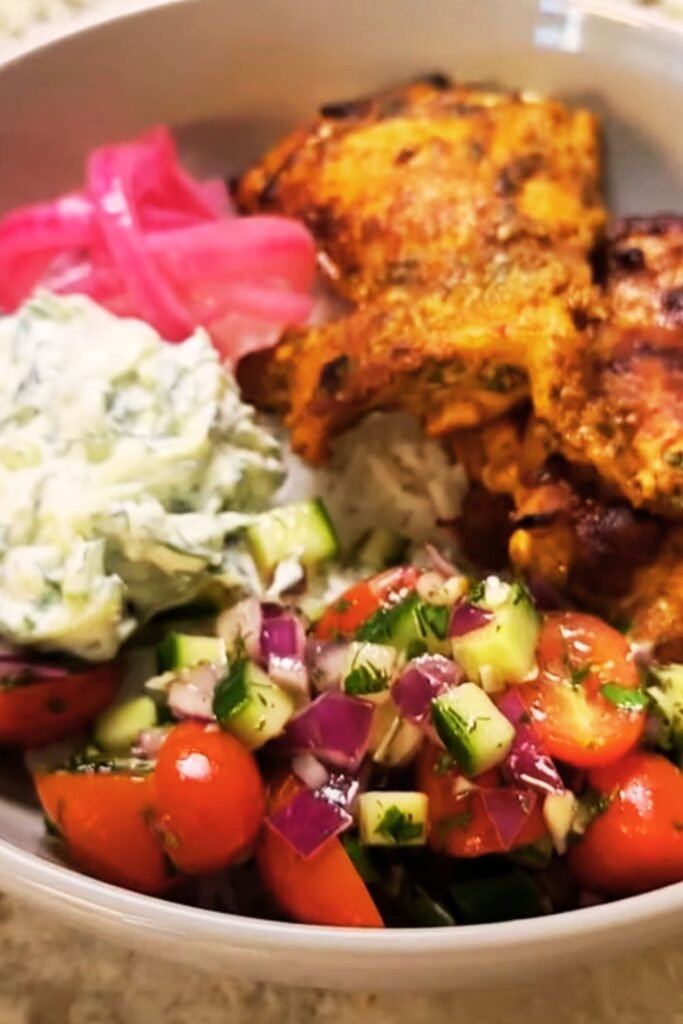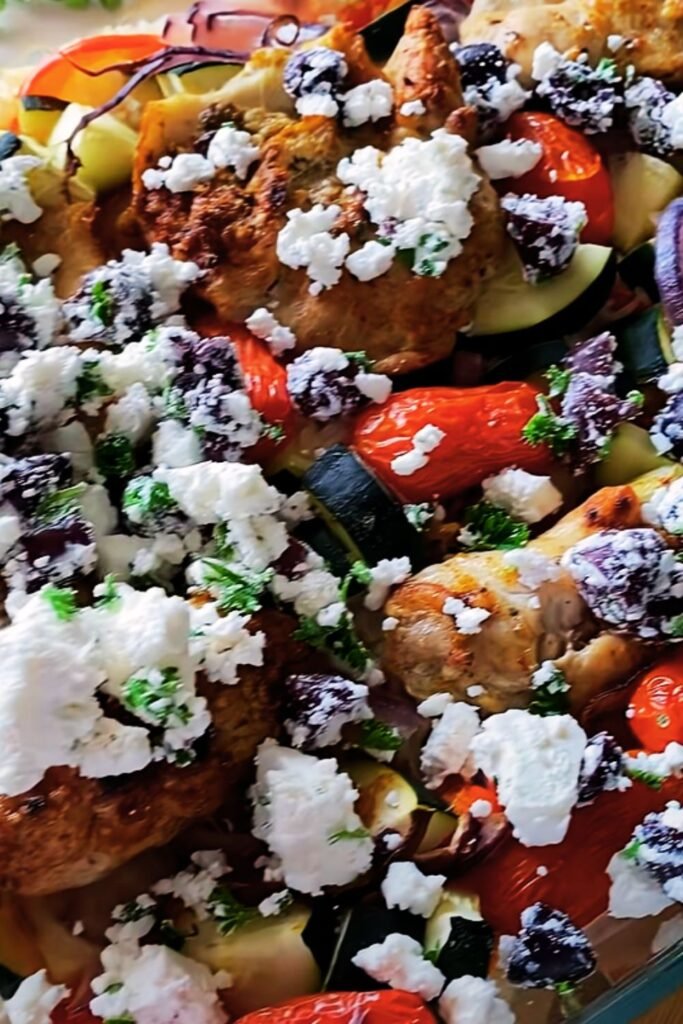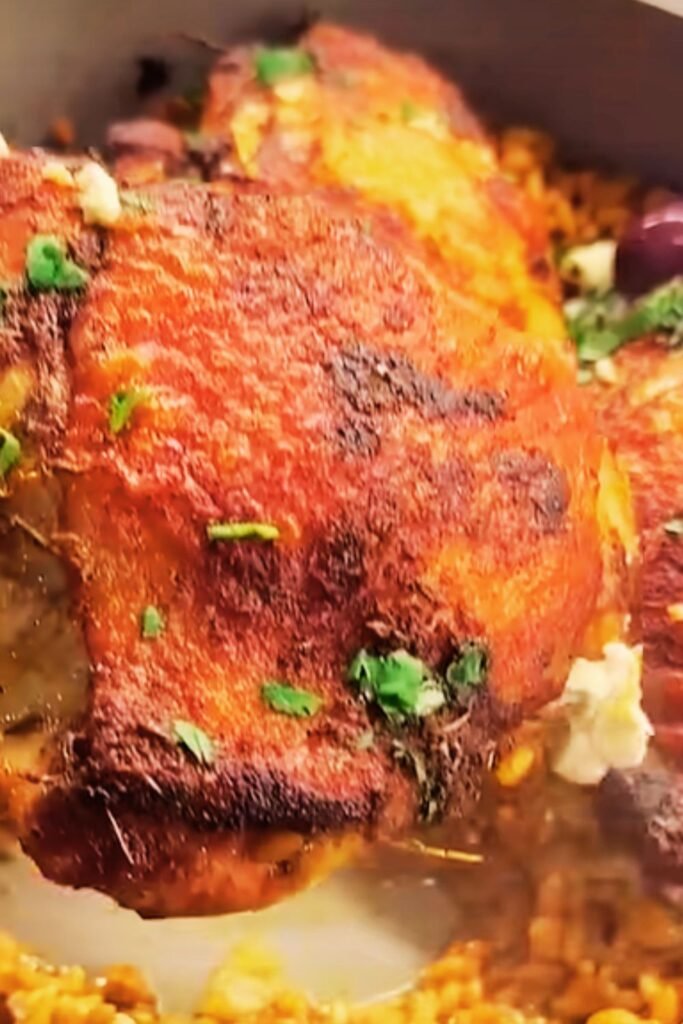When I first discovered Mediterranean cuisine during my travels through Greece and Italy, I was captivated by how simple ingredients could create such extraordinary flavors. Among all the dishes I encountered, Mediterranean Chicken and Rice became my absolute favorite—a perfect harmony of tender chicken, aromatic herbs, and fluffy rice that captures the essence of coastal living in every bite.
This isn’t just another chicken and rice recipe; it’s a culinary journey that transforms your kitchen into a Mediterranean seaside taverna. The beauty lies in its simplicity and the way each ingredient complements the others, creating a symphony of flavors that’s both comforting and sophisticated.
What Makes This Dish Authentically Mediterranean?
Mediterranean cuisine is renowned for its emphasis on fresh, wholesome ingredients and cooking methods that have been passed down through generations. My version of Mediterranean Chicken and Rice incorporates the fundamental elements that define this beloved culinary tradition:
Key Mediterranean Elements:
- Olive Oil: The liquid gold of the Mediterranean, providing richness and depth
- Fresh Herbs: Oregano, thyme, and parsley that grow wild along Mediterranean coasts
- Aromatic Vegetables: Onions, garlic, and tomatoes forming the holy trinity of flavor
- Citrus: Lemon juice and zest that brighten every component
- Quality Spices: Paprika and bay leaves that add warmth without overwhelming
The magic happens when these ingredients meld together in one pan, allowing the rice to absorb all the wonderful flavors while the chicken becomes incredibly tender and aromatic.
Essential Ingredients Breakdown
Understanding each ingredient’s role helps you appreciate why this dish works so beautifully. Here’s my detailed breakdown of what makes this recipe special:
Protein Foundation
Chicken Thighs vs. Breasts: I always recommend bone-in, skin-on chicken thighs for this recipe. They remain juicy during the longer cooking process and add incredible flavor to the rice. However, if you prefer chicken breasts, I’ll share adaptation tips later.
Rice Selection
Arborio Rice: My preferred choice because it absorbs flavors beautifully while maintaining a creamy texture Bomba Rice: The traditional Spanish variety, perfect if you can find it Long-grain Rice: Works well as a substitute, though the texture will be slightly different
Flavor Builders
The aromatic base consists of yellow onions, fresh garlic, and ripe tomatoes. I’ve learned that using San Marzano tomatoes when available elevates the dish significantly, but quality canned diced tomatoes work perfectly too.

Complete Recipe with Detailed Instructions
Ingredients List
| Component | Ingredient | Quantity | Notes |
|---|---|---|---|
| Protein | Bone-in, skin-on chicken thighs | 8 pieces (about 3 lbs) | Can substitute with 6 chicken breasts |
| Rice | Arborio or Bomba rice | 2 cups | Long-grain rice works as substitute |
| Aromatics | Yellow onion, diced | 1 large | About 1½ cups when diced |
| Fresh garlic, minced | 6 cloves | Don’t substitute with powder | |
| Diced tomatoes | 1 can (14 oz) | San Marzano preferred | |
| Liquids | Chicken stock | 4 cups | Low-sodium recommended |
| Extra virgin olive oil | ¼ cup | Quality makes a difference | |
| Fresh lemon juice | 3 tablespoons | About 1 large lemon | |
| Dry white wine | ½ cup | Optional but recommended | |
| Seasonings | Dried oregano | 2 teaspoons | Mediterranean oregano if available |
| Sweet paprika | 1 tablespoon | Spanish paprika preferred | |
| Fresh thyme | 2 tablespoons | Or 2 teaspoons dried | |
| Bay leaves | 2 leaves | Remove before serving | |
| Sea salt | To taste | Start with 1 teaspoon | |
| Black pepper | ½ teaspoon | Freshly ground | |
| Lemon zest | 1 tablespoon | From the juiced lemon | |
| Garnish | Fresh parsley | ½ cup chopped | Flat-leaf preferred |
| Kalamata olives | ½ cup pitted | Optional but authentic | |
| Feta cheese | ½ cup crumbled | For serving |
Step-by-Step Cooking Method
Preparation Phase (15 minutes)
- Season the chicken: Pat chicken thighs dry and season generously with salt, pepper, oregano, and paprika. Let them rest at room temperature for 15 minutes while you prepare other ingredients.
- Prep vegetables: Dice the onion finely, mince garlic, and measure out all spices. Having everything ready makes the cooking process smooth and stress-free.
Cooking Process
Step 1: Building the Foundation (8-10 minutes) Heat your paella pan or large, heavy-bottomed skillet over medium-high heat. Add 2 tablespoons of olive oil and let it shimmer. Place chicken thighs skin-side down and cook without moving for 5-6 minutes until the skin is golden brown and crispy. Flip and cook another 3-4 minutes. The chicken won’t be fully cooked—that’s intentional. Remove and set aside.
Step 2: Creating the Sofrito (5-7 minutes) In the same pan with the rendered chicken fat and oil, add diced onions. Cook until translucent and slightly golden, about 4 minutes. Add minced garlic and cook for another minute until fragrant. This mixture, called sofrito in Spanish cuisine, forms the flavor foundation of our dish.
Step 3: Building Layers of Flavor (3-5 minutes) Add the diced tomatoes, remaining oregano, thyme, and bay leaves. Cook until the tomatoes break down and the mixture becomes paste-like. If using wine, add it now and let it reduce by half. This concentrated base will infuse the rice with incredible depth.
Step 4: The Rice Addition (2 minutes) Add the rice to the pan, stirring to coat each grain with the aromatic mixture. This toasting step, similar to making risotto, helps the rice maintain its texture and absorb flavors more effectively.

Step 5: The Simmer (25-30 minutes) Pour in the warm chicken stock and add lemon juice and zest. Nestle the chicken thighs back into the pan, skin-side up. Bring to a gentle boil, then reduce heat to low and simmer uncovered for 25-30 minutes. Resist the urge to stir—this allows the rice to cook evenly and develop the coveted socarrat (the slightly crispy bottom layer).
Step 6: The Rest (10 minutes) Remove from heat and cover with a clean kitchen towel, then the lid. Let it rest for 10 minutes. This resting period allows the rice to finish cooking in its own steam and the flavors to meld completely.
Nutritional Information
| Nutrient | Per Serving (serves 6) | Daily Value % |
|---|---|---|
| Calories | 485 | 24% |
| Protein | 32g | 64% |
| Carbohydrates | 38g | 13% |
| Dietary Fiber | 2g | 8% |
| Total Fat | 22g | 28% |
| Saturated Fat | 6g | 30% |
| Cholesterol | 125mg | 42% |
| Sodium | 680mg | 30% |
| Potassium | 420mg | 9% |
| Vitamin C | 15mg | 17% |
| Iron | 2.8mg | 16% |
Cooking Tips and Techniques for Perfect Results
Through years of perfecting this recipe, I’ve discovered several techniques that guarantee success every time:
Temperature Control Mastery
The key to perfect Mediterranean Chicken and Rice lies in temperature management. Start with medium-high heat for browning, then reduce to low for the simmering phase. If your rice starts bubbling too vigorously, lower the heat further. The goal is a gentle, steady simmer that allows even cooking without burning.
The Liquid Ratio Secret
I use a 1:2 rice-to-liquid ratio, but here’s my secret: I warm the chicken stock before adding it to the pan. Cold liquid can shock the cooking process and result in uneven texture. Keep extra warm stock nearby in case you need to add more during cooking.
Achieving the Perfect Socarrat
The socarrat—that golden, slightly crispy layer at the bottom—is prized in Mediterranean cooking. To achieve it, increase the heat slightly during the last 2-3 minutes of cooking. You’ll hear gentle crackling sounds, which indicate the bottom is caramelizing perfectly.
Variations and Adaptations
One of the reasons I love this recipe is its adaptability. Here are my favorite variations that maintain the Mediterranean spirit while offering exciting twists:
Seafood Mediterranean Rice
Replace chicken with a mixture of shrimp, mussels, and calamari. Add the seafood during the last 10 minutes of cooking to prevent overcooking. This version reminds me of the coastal paellas I enjoyed in Valencia.
Vegetarian Mediterranean Rice
Substitute chicken stock with vegetable stock and add roasted red peppers, artichoke hearts, and chickpeas. The result is equally satisfying and captures the essence of Mediterranean vegetable gardens.
Spicy Moroccan-Inspired Version
Add a teaspoon of harissa paste with the tomatoes and include preserved lemons for an North African twist that still honors Mediterranean traditions.

Wine and Beverage Pairings
The right beverage can elevate your Mediterranean Chicken and Rice experience. Here are my carefully selected pairings:
Non-Alcoholic Options
- Sparkling Water with Lemon: The effervescence and citrus complement the dish’s bright flavors
- Mint Tea: A traditional Mediterranean choice that aids digestion
- Fresh Lemonade: Echoes the lemon notes in the dish
- Pomegranate Juice: Adds antioxidants and a subtle tartness
Herbal Infusions
- Rosemary and Thyme Tea: Mirrors the herbs in the dish
- Chamomile with Honey: A soothing option for evening meals
Storage and Reheating Guidelines
Proper storage ensures you can enjoy leftovers while maintaining the dish’s quality:
Refrigerator Storage
Store in airtight containers for up to 4 days. I recommend separating the chicken from the rice if possible, as they reheat at different rates.
Freezer Storage
This dish freezes beautifully for up to 3 months. Portion into individual servings for convenient reheating. Thaw overnight in the refrigerator before reheating.
Reheating Methods
| Method | Instructions | Time | Best For |
|---|---|---|---|
| Oven | Cover with foil, heat at 350°F | 15-20 min | Large portions |
| Stovetop | Add 2 tbsp stock, cover and heat | 8-10 min | Small portions |
| Microwave | Cover, heat on 70% power | 2-3 min | Individual servings |
| Steamer | Steam in covered pan | 5-7 min | Maintains moisture |
Serving Suggestions and Accompaniments
Mediterranean Chicken and Rice shines as a complete meal, but these accompaniments create a more elaborate feast:
Traditional Sides
- Greek Salad: The crisp vegetables and tangy feta provide a refreshing contrast
- Tzatziki: The cool cucumber yogurt sauce balances the warm, savory rice
- Hummus with Warm Pita: Adds protein and creates a mezze-style presentation
- Roasted Vegetables: Zucchini, eggplant, and bell peppers drizzled with olive oil
Fresh Additions
- Lemon Wedges: Always serve with extra lemon for brightening
- Fresh Herb Salad: A mixture of parsley, mint, and dill
- Pickled Vegetables: Adds acidity and cuts through the richness
Common Mistakes and How to Avoid Them
Learning from mistakes has made me a better cook, and I want to share these lessons with you:
Mistake 1: Stirring the Rice Too Much
Unlike risotto, this dish requires minimal stirring once the liquid is added. Excessive stirring can make the rice mushy and prevent proper cooking.
Mistake 2: Using Cold Stock
Always warm your stock before adding it. Cold liquid can stop the cooking process and result in uneven texture.
Mistake 3: Overcrowding the Pan
Use a pan that’s large enough to accommodate everything in a single layer. Overcrowding leads to uneven cooking and steaming rather than proper simmering.
Mistake 4: Skipping the Resting Period
The 10-minute rest after cooking is crucial. It allows the rice to finish cooking and the flavors to meld completely.
Health Benefits of Mediterranean Cuisine
This dish embodies the health principles that make Mediterranean cuisine one of the world’s most nutritious:
Heart-Healthy Fats
The olive oil provides monounsaturated fats that support cardiovascular health. Studies show that regular consumption of olive oil can reduce inflammation and lower risk of heart disease.
Lean Protein
Chicken provides complete proteins essential for muscle maintenance and repair. The cooking method preserves nutrients while developing complex flavors.
Antioxidant-Rich Ingredients
Tomatoes provide lycopene, herbs offer various antioxidants, and lemon contributes vitamin C. These compounds work together to support immune function and fight oxidative stress.
Complex Carbohydrates
Rice provides sustained energy release, making this dish satisfying without causing blood sugar spikes when consumed as part of a balanced meal.
Questions and Answers
Q. Can I make this dish in a regular skillet instead of a paella pan? Absolutely! While a paella pan creates the most authentic presentation, a large, heavy-bottomed skillet works perfectly. I’ve made this recipe countless times in my cast-iron skillet with excellent results. Just ensure your pan is large enough to accommodate everything in a single layer.
Q. What’s the best way to know when the rice is perfectly cooked? The rice should be tender with a slight bite, similar to al dente pasta. I test by tasting a few grains from the center of the pan after 25 minutes. If it needs more time, add a splash of warm stock and continue cooking for 3-5 minutes.
Q. Can I prepare this dish ahead of time for entertaining? Yes, but with some modifications. I recommend cooking it completely, then reheating gently with a bit of additional stock. For best results, prepare it no more than a day ahead. The flavors actually improve overnight, making it perfect for dinner parties.
Q. Why does my rice sometimes turn out mushy? Mushy rice usually results from too much liquid, excessive stirring, or overcooking. Stick to the 1:2 rice-to-liquid ratio, stir minimally once the stock is added, and watch the timing carefully. Different rice varieties may require slight adjustments.
Q. What can I substitute for white wine in the recipe? You can replace white wine with additional chicken stock, white grape juice, or simply omit it entirely. The wine adds depth, but the dish remains delicious without it. I sometimes use a splash of white wine vinegar for acidity.
Q. How do I prevent the bottom from burning? Use medium-low heat during the simmering phase and ensure your pan distributes heat evenly. If you smell any burning, immediately reduce the heat or add a splash of stock. A well-developed socarrat should smell toasty, not burnt.
Q. Can I use brown rice instead of white rice? Brown rice requires more liquid and longer cooking time. Increase the stock to 5 cups and extend the cooking time to 40-45 minutes. The texture will be chewier, but the nutritional value increases significantly.
Q. What’s the secret to getting crispy chicken skin? Pat the chicken completely dry before seasoning, and don’t move it once it hits the hot oil. Let it cook undisturbed for 5-6 minutes until it releases naturally from the pan. Starting with room temperature chicken also helps achieve better browning.
Q. How can I make this dish dairy-free? The base recipe is naturally dairy-free! Simply omit the feta cheese garnish or substitute with dairy-free alternatives like cashew-based cheese. The dish is still incredibly flavorful without any dairy additions.
Q. What’s the best way to reheat leftovers without drying them out? Add 2-3 tablespoons of chicken stock or water before reheating. Cover tightly and heat gently, either in the oven at 350°F or on the stovetop over low heat. The added moisture prevents the rice from drying out and helps redistribute the flavors.
This Mediterranean Chicken and Rice recipe has become my go-to dish for both weeknight dinners and special occasions. Its versatility, incredible flavors, and the way it brings people together around the table make it truly special. Every time I prepare it, I’m transported back to those sun-drenched Mediterranean coastlines where I first fell in love with this style of cooking. I hope it brings the same joy and delicious memories to your kitchen and dining table.